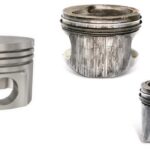Slide 1. Introduction.
The class develops when to align a vehicle's steering and the implications for fleet management.
Slide 2. When to align the vehicle's steering.
One of the key aspects of safe and comfortable driving is correct wheel alignment. Although it often goes unnoticed, a slight misalignment in the steering system can cause anything from uneven tire wear to loss of control during certain maneuvers.
Knowing when to align the steering and why it is so important can save you scares, unnecessary trips to the repair shop, and even accidents.
- Why is it important to align the steering?.
Alignment refers to adjusting the angles of the wheels so that they remain parallel to each other and perpendicular to the pavement, allowing the vehicle to travel in a straight line, reducing uneven tire wear, and optimizing its performance on the road.
Over time, or after certain impacts, these angles are altered, affecting stability and steering response. The most common causes of misalignment are usually:
-
- Hitting curbs or potholes.
- Frequent driving on uneven roads.
- Replacement of tires or suspension components.
- General wear and tear.
- Clear signs that you need to have your steering aligned.
Some signs that your car needs urgent alignment are:
1. The car veers off course when you release the steering wheel.
If, when you release the steering wheel on a straight road, you notice that the vehicle tends to veer to one side for no reason, this is a clear sign of misalignment.
2. Uneven tire wear.
Check the tread on your tires. If you see areas that are more worn than others, especially on the edges, it is likely that the alignment is affecting the tire's contact with the road.
3. Steering wheel vibrations.
Although this may also be related to balancing, a steering wheel that vibrates at certain speeds may be due to misalignment affecting the axle geometry.
4. Difficulty turning or stiff steering wheel.
A steering wheel that becomes more difficult to move, or that turns imprecisely, may be warning of an alignment or even power steering problem.
5. Abnormal noises when driving.
If you hear strange noises, especially when turning, there may be a problem with the steering system or the wheel angles.
- How often should the steering be aligned?.
There is no set mileage for this maintenance, but it is recommended to check it:
-
- When changing tires.
- After a hard impact against a curb or pothole.
- After replacing suspension or steering parts.
- When you notice any of the above signs.
- As part of preventive maintenance, at least once a year.
Timely alignment not only improves safety, it also helps save money by preventing premature tire wear.
- What is the difference between tire alignment and balancing?.
These two concepts are often confused, but they are different:
- Alignment: the angles of the wheels are adjusted to ensure that they are properly aligned and the car drives straight.
- Tire balancing: the weight distribution of the tire-rim assembly is corrected to prevent vibrations when driving.
Both processes are complementary and are usually performed together at the repair shop to ensure optimal vehicle performance.
- Implications for fleet management.
A vehicle with misaligned steering has the negative consequences described above, which can lead to accidents and increased costs because the tires wear unevenly and need to be replaced.
A simple alignment can make the difference between safe driving and an expensive breakdown.
The driver of the vehicle adapts to the symptoms of steering misalignment because it occurs gradually over time, and does not notice that the steering is misaligned, and does not notify the workshop manager or fleet manager that the steering is misaligned.
Drivers must be trained on the symptoms of misaligned steering so that they know when it is occurring and can notify the workshop manager or fleet manager.
If you have detected that the steering is not aligned, it must be aligned as soon as possible; do not wait until the tires are changed or the next maintenance check.
- Slide 3. Thank you for your time.
The class has developed when to perform a vehicle steering alignment and the implications for fleet management.
Download the audio




















